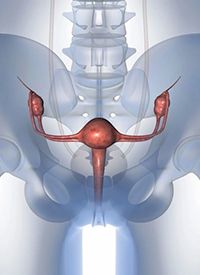Article
China Green Lights Olaparib for First-line Maintenance in HRD+ Advanced Ovarian Cancer
Author(s):
Olaparib plus bevacizumab was approved in China as a first-line maintenance treatment for homologous recombination deficiency–positive ovarian cancer following a response to platinum-based chemotherapy plus bevacizumab.
Ovarian Cancer

China’s National Medical Products Administration has approved olaparib (Lynparza) plus bevacizumab (Avastin) as a first-line maintenance treatment for adult patients with homologous recombination deficiency (HRD)–positive ovarian cancer who achieved a response to platinum-based chemotherapy plus bevacizumab.1
The approval was based on findings from an exploratory analysis of the HRD-positive subgroup in the phase 3 PAOLA-1 trial (NCT02477644). Patients with HRD-positive disease treated with olaparib plus bevacizumab maintenance (n = 255) achieved a clinically meaningful improvement in overall survival (OS) compared with patients treated in the placebo arm (n = 132). The combination reduced the risk of death by 38% compared with bevacizumab plus placebo (HR, 0.62; 95% CI, 0.45-0.85).2
The median OS was 75.2 months in the experimental arm compared with 57.3 months in the placebo arm (HR, 0.62; 0.45-0.85). Additionally, the 5-year OS rate was 65.5% in the olaparib arm compared with 48.4% in the placebo arm.
“Ovarian cancer has the highest fatality rate among gynecologic cancers in China. The emergence of PARP inhibitors and their application in the first-line treatment of ovarian cancer could help patients delay disease progression and achieve long-term remission,” Ding Ma, PhD, a member of the Chinese Academy of Engineering, stated in a press release. “In the PAOLA-1 trial, the combination of olaparib and bevacizumab demonstrated clinically meaningful improvements in overall survival. This approval provides HRD-positive patients with a new option for first-line maintenance therapy.”
The double-blind, international PAOLA-1 trial enrolled patients with newly diagnosed, advanced FIGO stage III to IV high-grade serous or endometroid ovarian, fallopian tube, and/or primary peritoneal cancer. Patients who experienced a complete response (CR) or partial response (PR) to first-line platinum-taxane chemotherapy plus bevacizumab were eligible for the trial.
Investigators randomly assigned 806 patients to 300 mg of olaparib twice daily or placebo for up to 24 months. All patients received concurrent bevacizumab at 15 mg/kg every 3 weeks for up to 15 months.3
Progression-free survival (PFS) served as the trial’s primary end point. Secondary end points included second PFS, OS, time to first subsequent therapy or death, time to second subsequent therapy or death, and safety.
Additional data showed that the median PFS was 46.8 months in the olaparib arm compared with 17.6 months in the placebo arm (HR, 0.41; 95% CI, 0.32-0.54).2 The 5-year PFS rates in the experimental and control arms were 46.1% and 19.2%, respectively.
The safety and tolerability profile of olaparib was consistent with observations from previous trials, with no new safety signals detected.
“Ovarian cancer has entered the era of precision medicine, and HRD detection [including BRCA1/2 mutations] has important clinical value for newly diagnosed patients with advanced ovarian cancer, to help guide first-line treatment decisions,” Beihua Kong, MD, chair of the Gynecological Oncology Branch of the Chinese Medical Association, stated in a press release. “The approval of the combination of olaparib and bevacizumab brings a clinically meaningful survival benefit to HRD-positive patients, and further reflects the importance of a precision approach to help guide treatment decisions in ovarian cancer.”
In May 2020, the FDA approved olaparib and bevacizumab for the maintenance treatment of patients with advanced ovarian cancer. The combination is indicated for patients who are in CR or PR to first-line platinum-based chemotherapy and whose cancer is associated HRD-positive status defined by either a deleterious or suspected deleterious BRCA mutation, and/or genomic instability, based on prior results from PAOLA-1.4
References
- Lynparza approved in China as 1st-line maintenance treatment with bevacizumab for HRD-positive advanced ovarian cancer. News release. AstraZeneca. September 22, 2022. Accessed September 22, 2022. https://bit.ly/3xJ5RR0
- Lynparza in combination with bevacizumab, and as a monotherapy, demonstrates clinically meaningful survival benefit in 1st-line advanced ovarian cancer across two phase III trials. News release. AstraZeneca. September 9, 2022. Accessed September 22, 2022. https://bit.ly/3xIPioo
- Platine, Avastin and olaparib in 1st Line (PAOLA-1). ClinicalTrials.gov. Updated August 2, 2022. Accessed September 22, 2022. https://clinicaltrials.gov/ct2/show/NCT02477644
- Lynparza approved in the US as 1st-line maintenance treatment with bevacizumab for HRD-positive advanced ovarian cancer. News release. AstraZeneca. May 11, 2020. Accessed September 22, 2022. https://bit.ly/3LwJzHX








